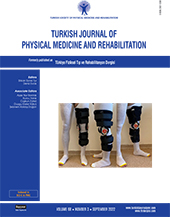Comparison of the efficacy of mud-pack and hot-pack treatments in chronic non-specific neck pain: A single-blind, randomized-controlled study
2 Department of Physical Medicine and Rehabilitation, University of Health Sciences, Konya Training and Research Hospital, Konya, Türkiye
3 Department of Medical Informatic, University of Health Sciences, Gülhane Faculty of Medicine, Ankara, Türkiye DOI : 10.5606/tftrd.2022.8575 Objectives: This study aims to compare the short-term efficacy of mud-pack (MP) and hot-pack (HP) treatments with the same temperature and duration on sleep, function, depression, and quality of life for chronic non-specific neck pain (CNNP) patients.
Patients and methods: Between December 2018 and September 2019, a total of 70 patients with CNNP diagnosis (12 males, 58 females; mean age: 50.2±9.4 years; range, 24 to 65 years) were included. The patients were divided into two groups. The MP group (n=35) had a total of 15 sessions of MP for 20 min + transcutaneous electrical nerve stimulation (TENS) for 20 min + home exercise (HE) on five days per week for three weeks. The HP group (n=35) had 15 similar sessions of HP for 20 min + TENS for 20 min + HE. The patients were assessed with the Visual Analog Scale (VAS-pain), VAS physician`s and patient`s global assessments, modified Neck Disability Index (mNDI), Beck Depression Inventory (BDI), Pittsburgh Sleep Quality Index (PSQI), and Short Form-36 (SF-36) measures before treatment, at the end of post-treatment third week and one month later.
Results: In the MP group, there were statistically significant improvements in all parameters at the end of treatment three-week and one-month follow-up (p<0.05), apart from SF-36 Vitality/Energy (SF-36V/E) at the end of treatment and SF-36 General Health (SF-36GH) at one month. In the HP group, there were statistically significant improvements observed for all parameters (p<0.05), apart from the SF-36 Physical Role and SF-36GH at the end of treatment third week and SF-36V/E at the first-month assessment. The VAS-pain(p<0.001), mNDI (p=0.019), BDI (p=0.002), SF-36GH (p<0.001), SF-36V/E (p<0.001) and SF-36 mental health (p<0.001) showed statistically significantly superior improvements in the MP group (p<0.05).
Conclusion: In CNNP patients, both MP and HP treatments are effective. However, MP therapy has more positive effects on pain, function, depression, and quality of life parameters. The MP treatment may be used in addition to TENS treatment for CNNP patients.
Keywords : Chronic neck pain, home exercise, hot pack, mud pack, thermotherapy
















